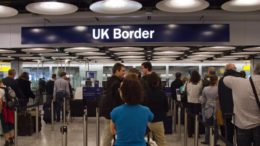Dear All,
The Workers of England has campaigned for controlled immigration to the UK (especially England as it is the most affected by immigration levels) because of the impact it has on reducing employment opportunities and reducing your wages.
The latest official figures show that Britain has experienced a population increase of 5,000,000 (million) people between 2005 and 2016. The article is worth reading as it helps explain why we are experiencing increased pressure on our services and resources. The Workers of England took the lead in highlighting these concerns because we knew wages and working conditions would be affected by uncontrolled immigration, this was confirmed by the then Leader of the Labour party Ed Miliband in Sept 2011, and Lord Rose, Head of ‘Remain Campaign’, in 2016.
We are at odds with the current Labour Party position on this as they are saying they want to maintain the single market which means that ‘uncontrolled immigration will continue’ with its obvious impact on your wages. the equation is easy: 10 people going for 1 job = higher wages and improved working conditions. 100 people going for 1 job = lower wages and poorer working conditions.
The Workers of England is not against immigration, all we want is to see it controlled. We believe that the current Labour Party position is wrong on this issue and needs to change!
Regards
Stephen Morris
General Secretary
Telegraph
Population growth sharpest in 70 years after ‘record’ migration levels
London grew by 2 per cent because of an influx of young workers CREDIT: JOHN HARPER/CORBIS DOCUMENTARY
- Olivia Rudgard, social affairs correspondent
22 JUNE 2017 • 6:33PM
The UK population has seen its sharpest increase in 70 years, driven by record levels of migration, official figures show.
Britain has experienced a population increase of five million people in just over a decade, between 2005 and 2016.
The previous five million took 35 years to achieve, between 1970 and 2005.
Figures released on Thursday by the Office of National Statistics, showed that the population increased by 538,000 during the year to June 2016, the largest numerical increase since 1947.
Following years of growth the population of the UK is now 65,648,000, the highest level ever recorded.
The ONS said that high levels of immigration had contributed to the statistics, which also show that the population has grown by 482,000 on average over the past ten years.
In its report it said: “Net international migration remains the largest component of population change.
“Overall, natural change accounted for 35.8 per cent of the population change, net international migration for 62.4 per cent and other changes 1.8 per cent.”
It added that “net migration remained around record levels, but it was stable compared with recent years”.
Net migration reached 332,300 in 2015, the highest level recorded since 1991. 299,200 people left the country and 631,500 arrived.
It has been growing ever since the early 1990s, when there was a brief period in which more people left the country than arrived, in 1992 and 1993.
A rise in births and decrease in deaths also contributed to the statistics.
Deaths fell by 2.6 per cent, which was partly because the most common strain of flu over the winter of 2015-16 affected young people more than older people.
This meant that winter mortality decreased compared to the winter of 2014-15.
Alistair Currie, head of campaigns at Population Matters, a charity which campaigns about the impact of high population levels, said: “These figures for the year up to June 2016 reflect the situation as it has been for many years now, with net migration being the highest driver of population growth.”
He added: “More people means more pressure on everything, from our food to our housing and from buses to butterflies.”
Most local authorities saw rises in their total population, and of the 26 which experienced falls, 17 were in coastal areas.
Growth was focused on England and in particular London, where population levels increased by 1.3 per cent.
This is driven by working-age people coming from abroad, but also by a higher birth rate because of the large number of young people.
Eight of the 14 authorities where population went up by 2 per cent or higher were in London.
Around 3.2m non-UK born residents were born in the EU, and 900,000 UK citizens are long-term residents of other EU countries.
Statisticians also reported that the UK’s population continued to age, though at a slower rate than in recent years, because most of the post-war “baby boomers” have now turned 65.

